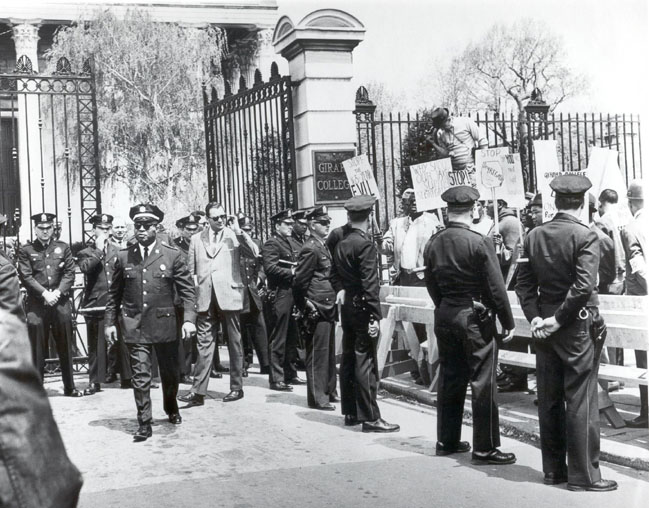BY GAYLE RONAN SIMS INQUIRER STAFF WRITER Marie Hicks [pictured, below], who in 1965-66 led thousands of pickets, including the Rev. Dr. Martin Luther King Jr., around the wall that stood between two of her sons and entry into Girard College because they were black, died Thursday of complications of Parkinson’s disease at Willow Terrace in Germantown. She was 83 and lived in Germantown.
The 10-foot wall and what it symbolized at Girard College inspired one of the most dramatic civil rights confrontations in Philadelphia history.
The journey to Girard began in 1965, when Mrs. Hicks wanted two of her sons, Charles and Theodore,
to be admitted to the whites-only school.
Her husband, Junius Hicks Sr., a World War II veteran who worked in a knitting mill and was a pilot, motorcyclist and watchmaker, died of cancer in 1964. Girard College had relaxed founder Stephen Girard’s orphans-only ban and accepted fatherless white boys.
Mrs. Hicks had gotten a peek behind the wall during a Boy Scout ceremony when her eldest son, Junius Jr., received a badge in front of Founder’s Hall.
“When I saw how beautiful everything was, it made me even more angry that no black boys were allowed in. I figured that I would never get in there again,” she told the Philadelphia Daily News in 1985.
Cecil B. Moore, president of the Philadelphia NAACP, who had already thrown up picket lines at Girard in June 1965, learned of Mrs. Hicks and her sons. He and lawyer William T. Coleman thought Mrs. Hicks was the kind of trailblazer they were looking for to join three other parent plaintiffs in a federal discrimination suit against the school.
In July 1965, they asked her to join the suit. It was the beginning of an ugly battle for Girard that ended in May 1968, when the U.S. Supreme Court threw out the last appeal to maintain the school for whites only. The Hicks family had endured more than 200 death threats, son Theodore Hicks said.
“I was an eyewitness to Mrs. Hicks marching at that wall every day for more than a year,” Bernard Smiley, chairman of the Board of Directors of City Trusts, the appointed agency that oversees Girard College, said yesterday.
“My father was there when Dr. King came to the wall. If there were one leader of the plaintiffs, it would be Marie Hicks. Her tiny stature — she was less than 5 feet tall — and her fiery, dynamic personality made her all the more effective as the spokesperson for those trying to gain entrance into Girard College.”
Finally, in September 1968, Theodore, then 9, and three other black students began classes at Girard. The court case had taken so long that son Charles was then 12, and Girard did not admit students older than 10. The school made an exception and Charles enrolled four months later.
Twenty years after the Supreme Court’s 1954 landmark school-desegregation case, Brown v. Board of Education, Charles became the first black graduate. Theodore, who graduated in 1977, was the first African American valedictorian.
INQUIRER: When All Eyes Were On The Prize

